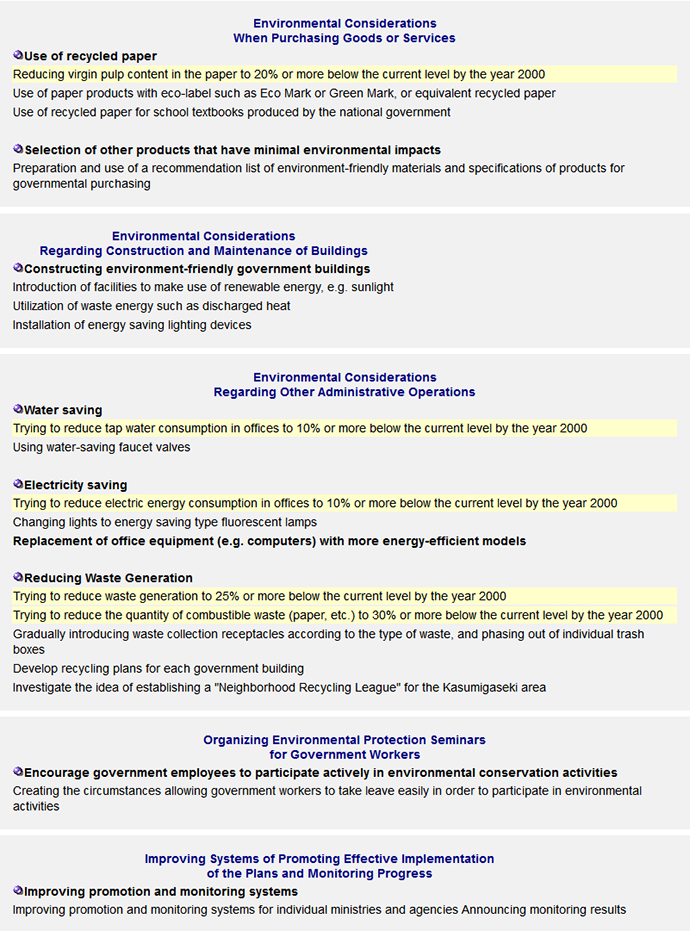Environmental Policy
The Action Plan for Greening Government Operations - Introduction
(CABINET DECISION)
JUNE 13, 1995
GOVERNMENT OF JAPAN
Formulation of the Action Plan for Greening Government Operations (Green Government Action Plan)
The Basic Environment Plan is aimed at creating a sustainable society that places a minimal burden on the environment, through the shared efforts of the national and local governments, corporations, citizens and NGOs, in particular through active, voluntary efforts on environmental conservation.
Based on the Basic Environment Plan, the role of the national government is to implement a range of environmental conservation policy measures with national objectives. Also, like ordinary corporations and households, the national government makes use of a variety of products and services and is responsible for the management and maintenance of buildings, thus plays a role in economic activities which require attention to environmental conservation.
National government accounts for 2.2% of gross national expenditure, which represents a significant amount of economic activity. So if the state conducts its economic activities in an environment-friendly way, it can make a major contribution to reducing the burden on the environment.
It is also very important that the government takes a lead in adopting environment-friendly actions to promote active voluntary participation in environment-oriented activities, in order to encourage this at the level of local governments, corporations and individuals.
On the basis of this awareness, in June 1995, the Cabinet decided on an Action Plan for Greening Government Operations (Green Government Action Plan). Details on the implementation of the plan were agreed at a Council of Ministries and Agencies Concerned on Promotion of the Basic Environment Plan (a director-general level council under the Cabinet).
Outline of the Green Government Action Plan
The Green Government Action Plan determines the actual measures to be carried out until the year 2000 in various areas. For example, when the government purchases any products or services it must consider environmental factors such as recycling and global warming. In addition, the government will promote the environmental considerations regarding construction and maintenance of all its buildings, and make efforts to save water and energy and to promote recycling at all its offices.
The plan sets out many concrete proposals including 11 numerical targets for achieving objectives on energy savings, use of recycled paper and the introduction of low-emission vehicles.
Recent Efforts
A survey was conducted to determine the progress in implementing the Green Government Action Plan at all ministries and agencies during FY1997. The findings were officially announced in a report in December 1998.
According to the survey, considerable progress was made in many fields since the previous year. However, in some fields, performance was still well short of targets. Most notably, the amount of waste was still excessive and the diffusion rate of low-emission vehicles (0.13%) was far below the target set for the year 2000 (10%).
Some of the most notable initiatives implemented recently include:
- A list of recommended environment-friendly products in four categories (e.g. copy paper) was formulated and distributed as a reference in order to help ministries and agencies make purchases that contribute to environmental conservation (June 1998).
- "A system of making use of bicycle within Kasumigaseki area where governmental head offices are concentrated" was put into practice (February 1999) to reduce the use of cars for local transport within short-distance area.
The national government is now taking steps towards meeting the targets set for the year 2000.
Green Government Action Plan and Items Agreed to Be Implemented
